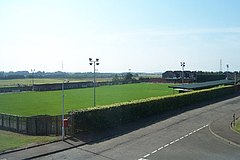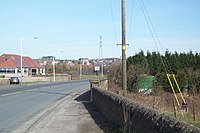Hill of Beath
Hill of Beath
| |
|---|---|
 Keirs Park, home of Hill of Beath Hawthorn | |
Location within Fife | |
| OS grid reference | NT160916 |
| Council area | |
| Lieutenancy area | |
| Country | Scotland |
| Sovereign state | United Kingdom |
| Post town | COWDENBEATH |
| Postcode district | KY4 |
| Dialling code | 01383 |
| Police | Scotland |
| Fire | Scottish |
| Ambulance | Scottish |
| UK Parliament | |
| Scottish Parliament | |
Hill of Beath ((/ˌhɪlˌəˈbiːθ/ ⓘ; Scots: Hill o Beath) is a hill and a village in Fife, Scotland, just outside Dunfermline and joined to Cowdenbeath.
On 16 June 1670 the Hill of Beath was the location of a celebrated meeting of the
The village at this location was built and owned by the Fife Coal Company, which rented the cottages to the miners for the duration of their employment in the mine. In 1896 the village population was about 1,300. As an experiment, a public house was started in June 1896 using the Gothenburg system, with any profits to be used for public works. An initial report suggested it was helping to reduce drunkenness despite the ease of access to public houses in nearby Crossgates.[4] In February 1901 an underground fire killed seven men.[5] Accidents, often fatal, were frequent in the years that followed.[6]
Hill of Beath is the birthplace of
The village has a primary school and a community centre.
-
Statue of Jim Baxter
-
A mixture of housing, public and private, looking towards Hill o' Beath
-
Hawthorn Crescent, Hill of Beath. The 'Hill' of Beath in the background
-
Hill of Beath from the road just east of Cuttlehill farm. A92 West Fife link road (dual carriageway) in foreground.
-
Woods planted on a restored open cast mining site.
-
B981 towards Cowdenbeath, situated over dual carriageway (A92) just short of bridge over railway. Hill of Beath ahead
See also
References
- ^ Stuart, Charles (1883). "Rev. John Blackadder". Notes and queries. Oxford University Press.
- ^ a b Dickson, John (1899). Emeralds chased in Gold; or, the Islands of the Forth: their story, ancient and modern. [With illustrations.]. Edinburgh and London: Oliphant, Anderson & Ferrier. pp. 206–208. Retrieved 3 March 2019.
 This article incorporates text from this source, which is in the public domain.
This article incorporates text from this source, which is in the public domain.
- ^ "Outed Ministers, Curates, Conventicles. and the Blink". The Reformation. 3 November 2011. Retrieved 12 February 2012.
- ^ "Hill of Beath Tavern". Scottish Mining Website. Retrieved 14 February 2012.
- ^ "Hill of Beath 15th February 1901". Scottish Mining Website. Retrieved 14 February 2012.
- ^ "Beath Parish: Accidents 1901 to 1914". Scottish Mining Website. Retrieved 14 February 2012.
- ^ "Statue to football legend unveiled". news.bbc.co.uk. 20 April 2003. Retrieved 11 February 2017.







